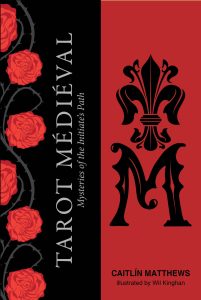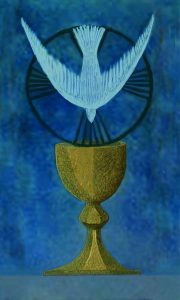
Caitlin Matthews; with illustrations by Wil Kingham
Red Feather (May 2023)
Reviewed by Wendy Stokes
A magnetic flip top box opens to display a comprehensive book and 78 cards. Size: 13.5 x 10.5 cm. Caitlin Matthews has translated, edited and provided additional material to revive an original, lost Tarot deck by Francis Rolt-Wheeler. The artwork is produced by Wil Kingham from originals by Christian Loring.
A fascinating story begins with the highly praised Christian Loring, who is a specialist in medieval art and knowledgeable about Qabala. She meets with the esoteric teacher and L’Astrosophie magazine publisher, Francis Rolt-Wheeler to produce a Tarot deck but during WW2 it becomes lost!
A glossary is provided that covers mythic, esoteric and specialist terms used by Rolt-Wheeler. This is a prize to possess and to work with and will improve readings by even experienced tarot readers. Several spreads are suggested and readings from the text are excellent.
The book covers the background story in detail, and the many influences on the original deck creators are described. Information is included on how to work with Medieval Tarot. We are provided with a colour reproduction of the modern artwork, and an excellent description of the cards, including upright and reversed meanings.
Each of the Majors have a title, alternative title, number, symbol and Hebrew letter, plus initiatory and mythic significance, symbolic correspondences with numerology, esoteric and exoteric astrology, geometric design and practical divinatory meanings. The Minors from Ace to Ten, are divided into four colour coded Temples: Blue Sceptres (Air), Red Swords (Fire), Green Cups (Water), Brown Shekels (Earth). The Court Cards are Pages, Knights, Queens and Kings, with extended textual information on the Queens and Kings.
The backs are deep rose pink with mirror images of Fleur de Lys in deeper colour. The elements of Air and Fire, and the numbering of the The Fool as XXI has been chosen by Oswald Wirth and Rolt-Wheeler.
The Minor cards from 2 -10 are not fully illustrated but represented as clearly identifiable pips, wood block style.
I would recommend this deck for a professional card reader who would like a deeper Tarot experience that requires study based on esoteric subjects.

Caitlin Matthews is the author of 80 books, and numerous DVDs, and courses. She is a world expert on many subjects and is the creator of Celtic Book of the Dead, Ancestral Oracle of the Celts, and Da Vinci Enigma Tarot. Wil Kingham has also provided artwork for The Shaman’s Oracle, The Steampunk Tarot, and The Circle of the Sidhe.








